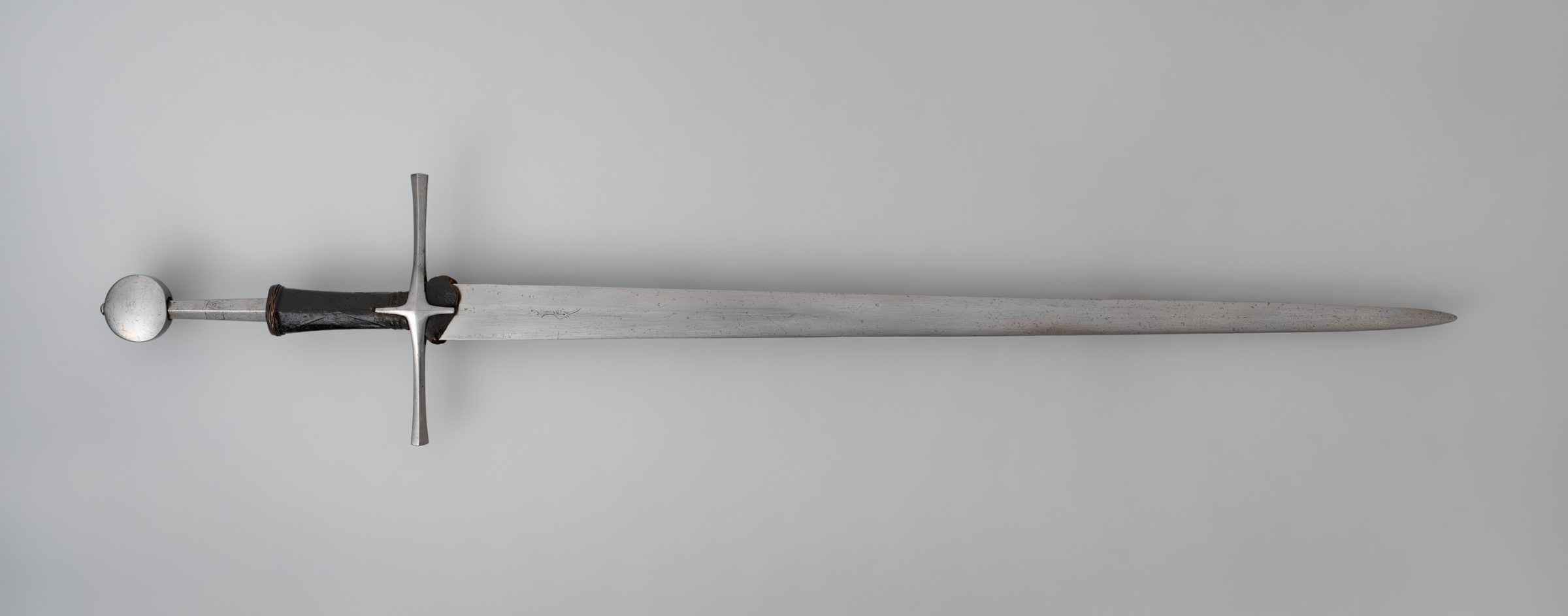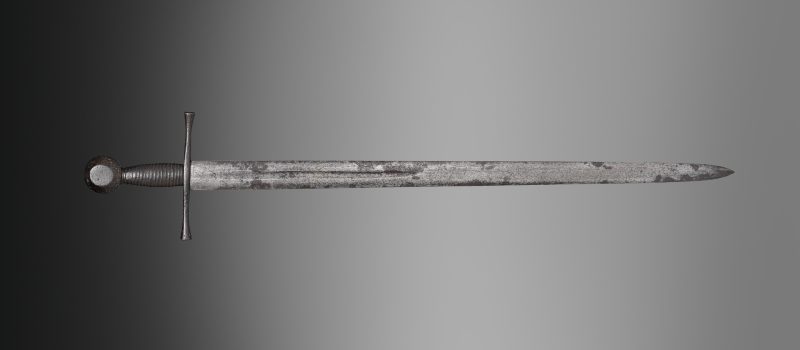Hand-and-a-Half Sword: Its History and Use in Combat

What’s in this article?
Equipped with a long grip, the hand-and-a-half sword was suitable for use with one or even both hands if one wished to give extra force to a blow. It was the typical knight’s sword of the 15th century designed for thrusting against vulnerable points in plate armor. Its handle featured a waisted shape, tapering towards shorter, thinner half-grips.
Learn more about the history and use of the hand-and-a-half sword and how it compares to other medieval swords.
Characteristics of a Hand-and-a-Half Sword
Hand-and-a-half swords have special half-grips that can be used with either one or both hands. Their handles have recognizable waist and bottle shapes which give a comfortable hold of the weapon.
Here are the unique characteristics of hand-and-a-half swords:
Metal and Construction
Historical hand-and-a-half sword blades were often made of a single piece of steel and were hardened by quenching. Today, replicas have high-carbon steel blades, though the ones used in stage combat and reenactment have blunt edges.
HEMA practitioners also use steel swords with unsharpened blades designed to bend in the thrust. On the other hand, those with stainless steel blades are only meant for decoration while LARP versions have foam blades.
Blade Appearance

The hand-and-a-half swords had straight, double-edged blades. Optimized for armored combat, their blades were steeply pointed, suggesting that their primary function was to pierce armor. Most were better suited for thrusting, but others were also designed for more cutting.
Most hand-and-a-half swords had a diamond cross-section with a central ridge, creating a more rigid blade and specialized anti-armor tip for thrusting. It does not mean that these blades could not cut well, though they were less optimized for slashing. Others also had hexagonal cross-sections that cut poorly towards the tip.
Size and Length
Hand-and-a-half swords varied in their blade length, usually ranging from 88 to 100 centimeters (35 to 40 inches). They had handles of roughly 17 to 25 centimeters (7 to 10 inches), excluding pommels, and weighed about 3 to 4 pounds.
Sword Mounting
Hand-and-a-half swords can be used with one or both hands as needed in combat. However, they had various hilt and guard forms depending on their origin.
Grip

Hand-and-a-half swords had long grips that permitted the use of the second hand. Their specially shaped grips, usually bottle-shaped or waisted, gave better control and hold of the weapon. They also had a pommel that counterbalanced the weight of the blade, improving its maneuverability.
Crossguard

Hand-and-a-half swords initially had a plain crossguard but later featured extensive hand guards. Some had straight or curved quillons (arms of the crossguard), side rings, finger rings, and loop-back guards. Others also had knuckle guards, particularly the Swiss style.
Scabbard
Scabbards protected the sword from dampness, rain, and were typically reinforced by a metal chape at the tip. They were made from wood, lined with cloth, and bound in leather. Hand-and-a-half swords were carried in scabbards attached to waist belts, though some sources mention swords being carried in rings welded directly to the skirt of a harness.
Hand-and-a-Half Sword vs. Arming Sword

The arming sword, also called the knightly sword, had a short grip and was designed to be wielded with one hand. On the contrary, the hand-and-a-half sword had a longer grip to allow it to be wielded with one or two hands, delivering a more powerful blow in one stroke if necessary.
The arming sword was paired with a small, round buckler shield on the left hand. On the other hand, the hand-and-a-half swords were often used alone. Still, some sources show them used with bucklers or spiked shields in judicial duels, though the latter was unusual.
If wielded in one hand, the hand-and-a-half sword functioned similarly to an arming sword, though its balance would be slightly different. As its name suggests, it had an advantage in terms of greater reach over the so-called short sword or arming sword.
Hand-and-a-Half Sword vs. Medieval Longsword

In HEMA, the term longsword refers to all swords with grips long enough to accommodate two hands yet lightweight enough to wield in one hand. Longswords have straight, double-edged blades and are small enough to be drawn from the belt. The term hand-and-a-half sword is often used interchangeably with longsword, although it is not entirely accurate.
The medieval longsword could include the earlier grete war swords, hand-and-a-half or bastard swords, and estocs. On the other hand, the term hand-and-a-half tends to describe later types of longswords with sharply tapering blades and specially shaped grips widely used in the 15th and 16th centuries.
The Hand-and-a-Half Sword in Combat
The hand-and-a-half swords optimized the combination of reach, maneuverability, and weight. Their long grip increased their striking power and made some fighting techniques easier.
The hand-and-a-half sword was used against mixed forces of knights, infantrymen, and archers.
The hand-and-a-half sword had a longer reach than the so-called short sword, the earlier arming sword, making it significant for a mounted knight fighting against other cavalry and foot soldiers. It could also be used one-handed against lightly armored archers from horseback and two-handed for thrusting attacks against heavily armored opponents.
The sharply tapered blades of hand-and-a-half swords were designed for thrusting against armor.
The earlier flatter blade types could not chop through plate armor, and its thin tip would only glance off instead of puncturing it. After the mid-14th century, sword blades became more sharply tapered toward the point, with diamond or hexagonal cross-sections to increase their rigidity for thrusting. However, the reduced weight near the tips made them less efficient for slashing.
Other parts of the hand-and-a-half sword could be used for offense.

In medieval fight books, the crossguard and pommel can be used for striking. The fighter could attempt to hit the opponent in the face using the pommel when wrestling with the sword, disarm, or throw him. In some instances, the crossguard could hook the shield or the weapon away and even trip the enemy.
Hand-and-a-half swords were suitable for the half-swording technique.

Half-swording (German halbschwert) refers to the technique of gripping the middle of the blade with the left hand to better control the tip of the sword. It allowed more accurate and powerful thrusts against armored opponents. The half-swording technique was essential in armored combat, as most cutting and slashing blows will not cause enough damage to an iron or steel plate.
The waisted shape of the hand-and-a-half sword made pommeling techniques easier.
The waisted grip, featuring a wider center tapering toward the pommel, allowed better control of the weapon. The hand could grip above or below the half-grip, or directly at the middle. It also allowed pommeling technique, in which the pommel is partially held in the palm of the other hand to execute more forceful thrusts into heavy armor.
Historical Facts About the Hand-and-a-Half Sword
The name hand-and-a-half is not a historical term. It was coined by modern collectors in the 19th century to refer to how the weapon is wielded. The hand-and-a-half sword was a balanced weapon that enabled one to use it with one or both hands.
The term bastard sword is an alternative name for the hand-and-a-half sword.
The hand-and-a-half sword is also called a bastard sword because it has no legitimate claim to being classified as either a one-handed or two-handed weapon. The name bastard sword was first used in the 15th century, as far as we know. Its French name épée bâtarde implies a sword of uncertain origin or an irregular sword.
It remains uncertain whether the name hand-and-a-half sword or bastard sword really applied to the earlier grete war sword.
The grete war sword, also called epee de guerre or great sword, was an earlier type of longsword used throughout most of western Europe. Some historians believe that it was primarily used in war and not an everyday weapon of the knight.
However, the grete war sword should not be confused with the extremely large great swords of the Renaissance that required the use of two hands. The term hand-and-a-half or bastard sword became a label to denote the later manifestations of these war swords or longswords.
Military tactics shaped the design of hand-and-a-half swords.

In the early Middle Ages, swords were broad and heavy and used to hack through the mail. As plate armor became more common, swords became longer and acquired a leaner blade with an acute point for thrusting. The hand-and-a-half swords had long, slender blades and sharp points that could penetrate the gaps in the opponent’s armor.
The hand-and-a-half sword falls in various Oakeshott types.
Ewart Oakeshott classified medieval swords into types, focusing on their blade type, pommel, and crossguard designs. The Oakeshott Type XVa is among the most common types of hand-and-a-half swords displayed in museums, including the Black Prince Sword, believed to be wielded by Edward, Prince of Wales. The hand-and-a-half sword also belongs to Oakeshott types XVIa, XVII, and XVIIIa.
The hand-and-a-half swords also served as sporting weapons.
When pike formations became common on battlefield tactics, ranged weapons proved more effective against pikemen, diminishing the advantages of hand-and-a-half swords. By the early 16th century, hand-and-a-half swords continued to be used by knights and men-at-arms in knightly duels and sporting competitions. Later on, the thrusting rapier gained favor as a civilian dueling weapon.
Conclusion
The hand-and-a-half sword falls somewhere in between the one-handed and two-handed weapons. Since it has no legitimate claim to being a member of either weapon family, it has earned the name bastard sword. These long-gripped weapons were ideal for thrusting at small gaps in armor when the typical slashing sword could not chop through it. Today, it is among the most common weapons used in HEMA.




